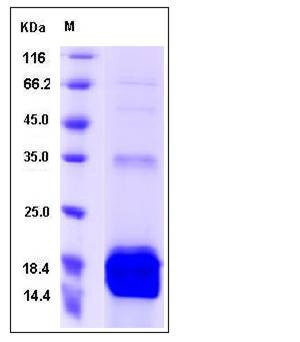Mouse S100A9 / CAGB / p14 Protein (His Tag)
60B8Ag,AW546964,BEE22,Cagb,GAGB,L1Ag,MRP14,p14
- 100ug (NPP3467) Please inquiry
| Catalog Number | P50284-M07E |
|---|---|
| Organism Species | Mouse |
| Host | E. coli |
| Synonyms | 60B8Ag,AW546964,BEE22,Cagb,GAGB,L1Ag,MRP14,p14 |
| Molecular Weight | The recombinant mouse S100A9 consisting of 128 amino acids and has a calculated molecular mass of 15 kDa. rmS100A9 migrates as an approximately 16-20 KDa band in SDS-PAGE under reducing conditions. |
| predicted N | Met |
| SDS-PAGE |  |
| Purity | > 95 % as determined by SDS-PAGE |
| Protein Construction | A DNA sequence encoding the mouse S100A9 (P31725) (Aal 2-Lys 113) was expressed, with a polyhistidine tag at the N-terminus. |
| Bio-activity | |
| Research Area | Neuroscience |Neurotransmission |Calcium Signaling |Calcium Binding Proteins |
| Formulation | Lyophilized from sterile PBS, 1mM DTT, 20% glycerol, pH 7.5 1. Normally 5 % - 8 % trehalose and mannitol are added as protectants before lyophilization. Specific concentrations are included in the hardcopy of COA. |
| Background | S100 protein is a family of low molecular weight protein found in vertebrates characterized by two EF-hand calcium-binding motifs. There are at least 21 different S100 proteins, and the name is derived from the fact that the protein is 100% soluble in ammonium sulfate at neutral pH. Most S100 proteins are disulfide-linked homodimer, and is normally present in cells derived from the neural crest, chondrocytes, macrophages, dendritic cells, etc. S100 proteins have been implicated in a variety of intracellular and extracellular functions. They are involved in regulation of protein phosphorylation, transcription factors, the dynamics of cytoskeleton constituents, enzyme activities, cell growth and differentiation, and the inflammatory response. Protein S100-A9, also known as S100 calcium-binding protein A9, S100A9, and CAGB, is a member of the S-100 family. S100A9 is expressed by macrophages in acutely inflammed tissues and in chronic inflammation. It is also expressed in epithelial cells constitutively or induced during dermatoses. S100A9 is a calcium-binding protein. It has anti-microbial activity towards bacteria and fungi. The anti-microbial and proapoptotic activity of S100A9 is inhibited by zinc ions. S100A9 plays a role in the development of endotoxic shock in response to bacterial lipopolysaccharide (LPS). It promotes tubulin polymerization when unphosphorylated. It also promotes phagocyte migration and infiltration of granulocytes at sites of wounding. S100A9 plays a role as a pro-inflammatory mediator in acute and chronic inflammation and up-regulates the release of IL8 and cell-surface expression of ICAM1. |
| Reference |
